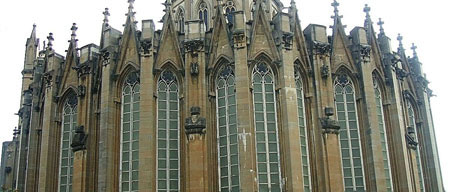Home > Study in Spain > City Guide > Vitoria
Vitoria City Guide
- Places of Interest
- Maps
- Getting to
- Getting around the city
The city of Vitoria-Gasteiz is the provincial capital of Álava and of the autonomous community of the Basque country in northern Spain. It is the second largest Basque city and the people are affectionately known as Babazorros which is Basque for "bean eaters". Spanish is the main language here, but knowledge of Basque is also highly common. Nobody knows exactly the origin of this language (Euskara). The city is very well connected to other major Spanish cities such as Bilbao, Pamplona, Santander, Zaragoza and Madrid. Important historical features of the city are that it has always been an important trading centre and all its inhabitants were declared equal, without distinction between nobles and the masses.
The city is now thriving with architectural splendour, a wide range of cultural amenities for both citizens and tourists and it is also the European city with the most consolidated green areas. The buildings vary from Gothic to Neoclassical styles and the city offers a large number of museums. In addition to this, the city boasts many annual festivals such as that of its patron saint, the Virgen Blanca, during the first week of August. Finally, the Basque cuisine is known to be that of the best in Spain and Bar Sagartoki was even awarded as being the best Spanish pintxos bar in 2006. If you want a true Basque experience, then hit the city's old medieval zone of "Casco Viejo" which is bursting with bars and get to grips with the true local culture. This city is one of a kind and is a perfect opportunity to relish in the Basque country.
Places of Interest
Plaza de España and the Town Hall
This is the best example of neoclassical art in the city and this group of buildings dates from the late 18th century. These buildings are a major milestone in the urban expansion beyond the bounds of the medieval city towards the south. This is a beautiful place to come, especially at night, as the Plazas of Spain are generally meeting points and it is a great place to see people come together in the evenings.
The Cathedral of Santa María
Visits here involve wearing a protective helmet and there are strict safety measures in place and current visits offer a great chance to see the restoration work first-hand. Visits generally need to be arranged through the website catedralvitoria.com by choosing a day available on the calendar and indicating the number of persons and which language you would like to receive the explanation in. Visits may also be allowed by requesting via telephone at 945 25 51 35 or by sending an e-mail to visitas@catedralvitoria.com
The Basilica of Armentia
This Basilica is one of the most important Romanesque churches in the province. During the late Middle Ages, there were references describing it as the most important spiritual centre in Alava. The restoration of the Basilica has been completely funded by the Caja Vital Kutxa savings bank in order to determine what Armentia was like in the 10th and 11th centuries.
Museums
ARTIUM Basque Centre – Museum of Contemporary Art
This museum was inaugurated on April 26 2002 and is open and highly dynamic. The museum's permanent collection is considered to be one of the best selections of Basque and Spanish contemporary art. There are some 2000 paintings, sculptures, engravings, and drawings, photographs and videos. The museum is open daily from the early morning until night time except for Mondays when it is closed. The general rate is €4,50 however there is a reduced tariff of €2,20.
Fine Arts Museum
This beautiful museum is housed in the Palacio de Augusri with a marvellous selection of Spanish art reaching as far back as the 18th and 19th centuries as well as a collection of artwork which traces the development of Basque art from 1850 to 1950. The building was constructed in 1912 by Julián de Apraiz and Javier Luque in the revival Renaissance style and in 1962, the building and its collection were declared a historic, artistic monument. The museum is open for most of the day except for during siesta however is closed on a Monday. And the best thing about the price is that there isn't one – it's free entry!!
Natural History Museum
This museum resides in the Torre de Doña Ochanda, a 15th century fortified house which formed part of the city's walls in medieval times. The museum's first floor is home to the Amber Room which is of a geology theme with numerous pieces of amber containing insect inclusions and on the second floor can be found the museum's permanent botany and zoology sections. There is also a collection of over 1000 insects coming from the Iberian Peninsula and from tropical countries. This museum also offers free entry and is open throughout the day except for siestas and Mondays.
Maps
Getting to Vitoria
By Air
Vitoria-Gasteiz airport (VIT) or Foronda is located only 9km to the north of the city with a small number of flight destinations and currently the prices are relatively low. There is a free, unguarded vehicle car park and a bus park. It is extremely easy to reach the city centre by bus or taxi from the airport. The shuttle bus seems to run times coinciding to major arrivals and departures and is only €3 each way. If you don't want to lug any luggage around, the station has some lockers which cost around €1 a day. Another option is arriving at Loiu airport in Bilbao airport and from here is it possible to take the urban bus service (Bizkaibus) which will take you to the central bus station and from there it is approximately less than an hour to reach Vitoria-Gasteiz.
By Train
The city has a fantastic rail connection and there are half a dozen trains running daily which link with the Spanish capital and, via Valladolid, the AVE arrives in an astonishing 3 hours 43 minutes. There are numerous other links throughout Spain and even into Portugal and France to Lisbon and Paris.
By Bus
The coach station runs many services coming into the city and there are a very large number of bus companies which support this such as Bilman Bus, Continental Auto, Eurobus, Alegría Hnos., Grupo Alsa-Enatcar, Grupo Arriaga, La Burundés SA, La Unión, Pesa, Socitransa and Vivaza.
Getting around the city
Vitoria-Gasteiz is itself a very small city and you can comfortably get around on foot as everything appears to be a step away however if you decide that you'd like to take it a bit more easily then of course the city has a thriving transport system and you can easily hop onto one of the buses which will quickly take you to your destination.

